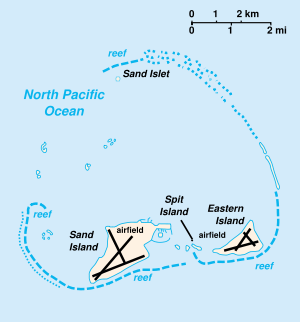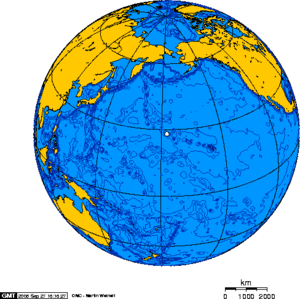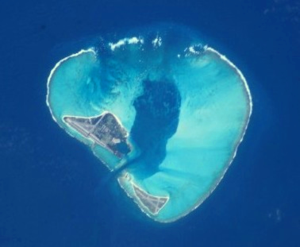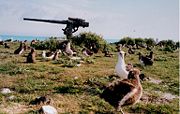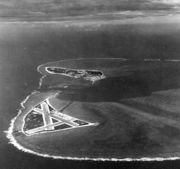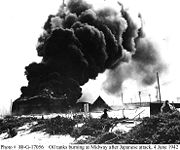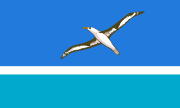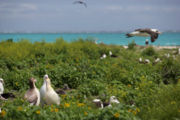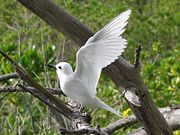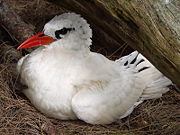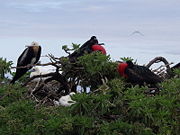Midway Atoll
2008/9 Schools Wikipedia Selection. Related subjects: Geography of Oceania (Australasia)
Midway Atoll (AKA Midway Island or Midway Islands, Hawaiian: Pihemanu) is a 2.4 square mile (6.2 km²) atoll located in the North Pacific Ocean (near the northwestern end of the Hawaiian archipelago), about one-third of the way between Honolulu and Tokyo. It is less than 140 nautical miles (259 km/161 mi) east of the International Date Line, about 2,800 nautical miles (5,200 km/3,200 mi) west of San Francisco and 2,200 nautical miles (4,100 km/2,500 mi) east of Tokyo. It consists of a ring-shaped barrier reef and several sand islets. The two significant pieces of land, Sand Island and Eastern Island, provide habitat for hundreds of thousands of seabirds. Island sizes are:
| Island | acres | hectares | |||||||
|---|---|---|---|---|---|---|---|---|---|
| Sand Island | 1,200 | 486 | |||||||
| Eastern Island | 334 | 135 | |||||||
| Spit Island | 6 | 2 | |||||||
| Sand Islet | |||||||||
| Midway Atoll | 1,540 | 623 | |||||||
| Lagoon | 14,800 | 6,000 | |||||||
According to other sources, Sand Island measures 1,250 acres ({{ Convert}} no longer accepts sqkm as code. Please use km2 instead. Please refer to {{convert}}'s talk page for the reasoning behind this. Sorry for any inconvenience.) in area and the lagoon within the fringing rim of coral reef 9,900 acres ({{ Convert}} no longer accepts sqkm as code. Please use km2 instead. Please refer to {{convert}}'s talk page for the reasoning behind this. Sorry for any inconvenience.). The atoll, which has a small population (40 in 2004, but no indigenous inhabitants), is an unincorporated territory of the United States, designated an insular area under the authority of the U.S. Department of the Interior. It is a National Wildlife Refuge administered by the U.S. Fish and Wildlife Service (FWS). The visitor program closed in January 2002 and there are no facilities at the present time for receiving visitors. However, visitors who are able to provide their own transportation can contact the refuge manager for information on visiting the atoll. The economy is derived solely from governmental sources. All food and manufactured goods must be imported.
Midway, as its name suggests, lies nearly halfway between North America and Asia.
Midway is best known as the location of the Battle of Midway, fought in World War II on June 4, 1942. Nearby, the United States Navy defeated a Japanese attack against the Midway Islands, marking a turning point in the war in the Pacific Theatre.
For statistical purposes, Midway is grouped as one of the United States Minor Outlying Islands.
Geography and geology
Midway Atoll is part of a chain of volcanic islands, atolls, and seamounts extending from Hawai'i up to the tip of the Aleutian Islands and known as the Hawaii-Emperor chain. Midway was formed roughly 28 million years ago when the seabed underneath it was over the same hotspot from which the Island of Hawai'i is now being formed. In fact, Midway was once a shield volcano perhaps as large as the island of Lana'i. As the volcano piled up lava flows building up the island, the load of it depressed the crust and the island slowly subsided over a period of millions of years, a process known as isostatic adjustment. As the island mass subsided, a coral reef around the former volcanic island was able to maintain itself near sea level by growing upwards. That reef is now over 516 feet (160 m) thick (Ladd, Tracey, & Gross, 1967; in the lagoon, 1,261 ft (384 m), comprised mostly post-Miocene limestones with a layer of upper Miocene (Tertiary g) sediments and lower Miocene (Tertiary e) limestones at the bottom overlying the basalts. What remains today is a shallow water atoll about 6 miles (10 km) across.
The islands of Midway Atoll have been extensively altered as a result of human habitation. Starting in 1869 with a project to blast the reefs and create a port on Sand Island, the ecology of Midway has been changing. Birds native to other Northwestern Hawaiian Islands, such as the Laysan Rail and Laysan Finch, were released at Midway. Ironwood trees from Australia were planted to act as windbreaks. Seventy-five percent of the 200 species of plants on Midway were introduced. The FWS has recently continued this trend by introducing the Laysan duck to the island, while, at the same time, extending efforts to exterminate other introduced species.
The atoll has some 20 miles (32 km) of roads, 4.8 miles (7.8 km) of pipelines, one port (on Sand Island), and one active runway (rwy 06/24, around 8,000 ft (2,400 m) long). As of 2004, Henderson Field airfield at Midway Atoll has been designated as an emergency diversion airport for aircraft flying under ETOPS rules. The FWS closed all airport operations on November 22, 2004. Public access to the island was restored beginning March 2008.
Uniquely among the Hawaiian islands, Midway observes UTC-11, eleven hours behind Coordinated Universal Time.
History
Nineteenth century
The atoll was discovered July 5, 1859 by Captain N.C. Middlebrooks, though he was most commonly known as Captain Brooks, of the seal hunting ship Gambia. The islands were named the "Middlebrook Islands" or the "Brook Islands". Brooks claimed Midway for the United States under the Guano Islands Act of 1856, which authorized Americans to temporarily occupy uninhabited islands to obtain guano. On August 28, 1867, Captain William Reynolds of the USS Lackawanna formally took possession of the atoll for the United States; the name changed to "Midway" some time after this. On 28 August 1867 the atoll became the first offshore islands annexed by the U.S. government, as the Unincorporated Territory of Midway Island; administered by the U.S. Navy. Midway was the only island in the entire Hawaiian archipelago that was not later part of the State of Hawaii.
The first attempt at "settlement" was in 1871, when the Pacific Mail and Steamship Company started a project of blasting and dredging a ship channel through the reef to the lagoon using money put up by the U.S. Congress. The purpose was to establish a mid-ocean coaling station avoiding the high taxes imposed at ports controlled by the Hawaiians. The project was shortly a complete failure, and the USS Saginaw, evacuating the last of the channel project's work force in October 1871, then ran aground at Kure Atoll, stranding all aboard.
Early twentieth century
In 1903, workers for the Commercial Pacific Cable Company took up residence on the island as part of the effort to lay a trans-Pacific telegraph cable. These workers introduced many non-native species to the island, including the canary, cycad palm, Norfolk Island pine, ironwood, coconut, and various deciduous trees, along with ants, cockroaches, termites, centipedes, and countless others.
Later that year, President Theodore Roosevelt placed the atoll under the control of the U.S. Navy, which on 20 January 1903 opened a radio station, in response to complaints from cable company workers about Japanese squatters and poachers. In 1904 - 1908 Roosevelt sent 21 U.S. Marines to stop the wanton destruction of bird life by Japanese poachers, and to keep Midway safe as a U.S. possession, protecting the cable station.
In 1935, operations began for the China Clipper, a large flying boat run by Pan American Airlines. The Clipper island-hopped from San Francisco to China, providing the fastest and most luxurious route to the Orient and bringing tourists to Midway until 1941. Only the extremely wealthy could afford a Clipper trip, which in the 1930s cost more than three times the annual salary of an average American. With Midway on the route between Honolulu and Wake Island, the large seaplanes landed in the quiet atoll waters and pulled up to a float offshore. Tourists were loaded onto a small powerboat that whisked them to a pier, where finally they would ride in "woody" wagons to the Pan Am Hotel or the "Gooneyville Lodge," named after the ubiquitous "Gooney birds" (albatrosses).
World War II
The location of Midway in the Pacific became important to the military. Midway was a convenient refueling stop on transpacific flights. It also became an important stop for Navy ships. Beginning in 1940, as tensions with the Japanese were rising, Midway was deemed second only to Pearl Harbour in importance to protecting the U.S. west coast. Airstrips, gun emplacements and a seaplane base quickly materialized on the tiny atoll. The channel was widened, and Naval Air Station Midway was completed. Architect Albert Kahn designed the Officer's quarters, the mall and several other hangars and buildings. Midway's importance to the U.S. was brought into focus on December 7, 1941 with the Japanese attack on Pearl Harbour. Six months later, on June 4, 1942, a naval battle near Midway resulted in the U.S. Navy exacting a devastating defeat of the Japanese Navy. This Battle of Midway was, by most accounts, the beginning of the end of the Japanese Navy's control of the Pacific Ocean. Midway was also an important submarine base for what was known as the Silent Service.
Korean and Vietnam Wars
From August 1, 1941 to 1945 it was occupied by U.S. military forces. In 1950, the Navy decommissioned Naval Air Station Midway, only to re-commission it again to support the Korean War. Thousands of troops on ships and planes stopped at Midway for refueling and emergency repairs. From 1968 to September 10, 1993 Midway Island was a Navy Air Facility. During the Cold War, the U.S. established a secret underwater listening post at Midway in an attempt to track Soviet submarines. These sensitive devices could pick up whale songs for miles and the facility remained top-secret until its demolition at the end of the Cold War. "Willy Victor" radar planes flew night and day as an extension of the DEW Line ( Distant Early Warning Line), and antenna fields covered the islands.
With about 3,500 people living on Sand Island, Midway also supported the U.S. troops during the Vietnam War. In June 1969, President Richard Nixon held a secret meeting with South Vietnamese President Nguyen Van Thieu at the Officer-in-Charge house or "Midway House".
Civilian rule
In 1978, the Navy downgraded Midway from a Naval Air Station to a Naval Air Facility and large numbers of personnel and dependents began leaving the island. With the conflict in Vietnam over, and with the introduction of reconnaissance satellites and nuclear submarines, Midway's significance to national security was diminished. The World War II facilities at Sand and Eastern Islands were listed on the National Register of Historic Places on May 28, 1987.
Midway was designated an overlay National Wildlife Refuge on April 22, 1988 while still under the primary jurisdiction of the Navy. As part of the Base Realignment and Closure process, the Navy facility on Midway has been operationally closed since September 10, 1993, although the Navy assumed responsibility for cleaning up environmental contamination at Naval Air Facility Midway Island.
Beginning 7 August 1996, the general public could visit the atoll through study ecotours. This program ended in 2002, but another visitor program was approved beginning March 2008.
On October 31, 1996, President Bill Clinton signed Executive Order 13022, which transferred the jurisdiction and control of the atoll to the U.S. Department of the Interior. The Fish and Wildlife Service assumed management of the Midway Atoll National Wildlife Refuge. The last contingent of Navy personnel left Midway on 30 June 1997, after an ambitious environmental cleanup program was completed.
On 15 June 2006, President George W. Bush designated the Northwestern Hawaiian Islands as a national monument. The Northwestern Hawaiian Islands Marine National Monument encompasses 137,797 square miles ({{ Convert}} no longer accepts sqkm as code. Please use km2 instead. Please refer to {{convert}}'s talk page for the reasoning behind this. Sorry for any inconvenience.), and includes 4,500 square miles ({{ Convert}} no longer accepts sqkm as code. Please use km2 instead. Please refer to {{convert}}'s talk page for the reasoning behind this. Sorry for any inconvenience.) of coral reef habitat. The Monument also includes the Hawaiian Island Reservation established by Theodore Roosevelt in 1909, the Hawaiian Islands National Wildlife Refuge, and the Midway Atoll National Wildlife Refuge.
In 2007, the Monument's name was changed to Papahānaumokuākea Marine National Monument, pronounced PA-pa-ha-NOW-mo-KUH-ah-KAY-uh. The National Monument is managed by the U.S. Fish and Wildlife Service and the National Oceanic and Atmospheric Administration (NOAA), in close coordination with the State of Hawaii.
Lead paint on the buildings still poses an environmental hazard to the albatross; the estimated cost of stripping the paint is estimated to be $5 million.
